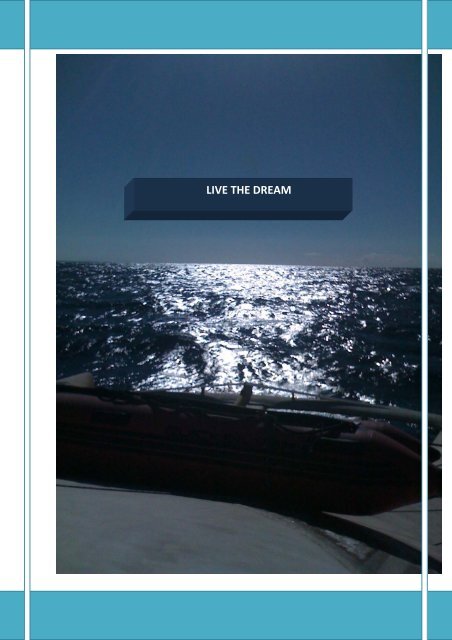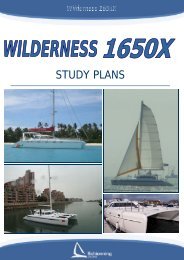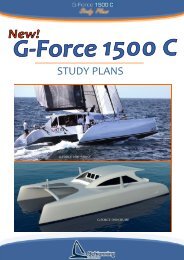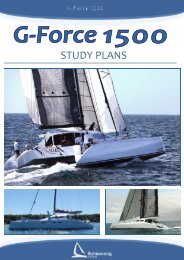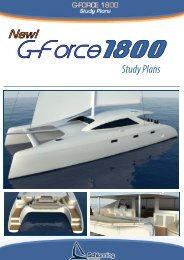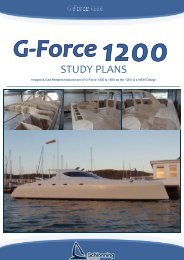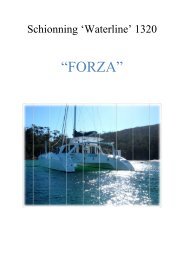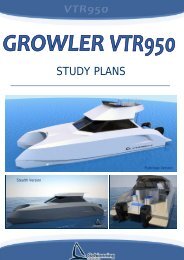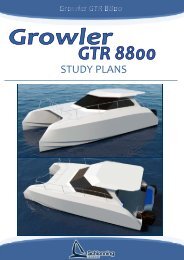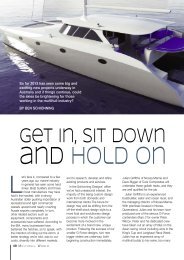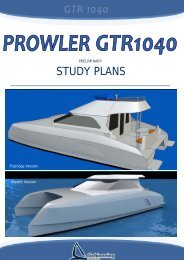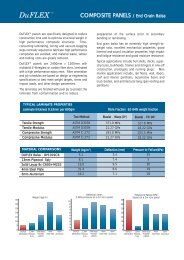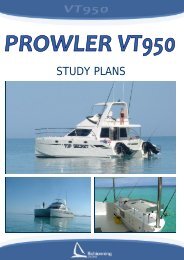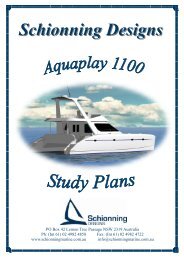read testimonial - Schionning Designs
read testimonial - Schionning Designs
read testimonial - Schionning Designs
Create successful ePaper yourself
Turn your PDF publications into a flip-book with our unique Google optimized e-Paper software.
LIVE THE DREAM
This is my dream which I am living....<br />
After pondering my association with the water and with the blessing<br />
of my dear wife, I negotiated<br />
the purchase of an unfinished project boat which was located in Western Port in<br />
Victoria. As<br />
I live<br />
on the Gold Coast the prospect of completing the project in Victoria was out of the question. I<br />
examined all alternatives for road and sea freight and the costs weree simply horrendous due<br />
to the<br />
length and width of the Catamaran. Whilst I had purchased a mast and rigging in<br />
Queensland<br />
I made<br />
the decision to make<br />
her seaworthy and motor the boat to Gold Coast. The cut outs for the<br />
windows were glassed back and fitted out for the trip. On advice from my brother I compared a<br />
number of production outboard motors and finally settled on my brother’s choice of two BF30hp<br />
Honda four stroke outboard to complete the<br />
trip. The choice was no<br />
doubt the right one with the<br />
motors not missing a beat for the whole trip<br />
to the Gold Coast, Queensland.<br />
I take this opportunity thank the<br />
following individuals for assisting with my journey from Western<br />
Port in Victoria to the Gold Coast on our <strong>Schionning</strong> Waterline 1320 (unfinished project boat). I am<br />
57 years<br />
of age and the trip will always remain in my memories as a great and memorable<br />
experience.<br />
Preparing my project boat was a challenge, installation of kick up rudders, hydrive steering, auto<br />
pilot, sounder, radar, electrical system, engine mounts, and motor installation all took time. I wish<br />
to thank<br />
my brotherr Sonny Wright, John Ratcliffe formerr owner of Baby 2 and friend, Jeff <strong>Schionning</strong><br />
the designer of the 1320, Ben, Brett and Loraine <strong>Schionning</strong> from <strong>Schionning</strong> Marine Port Stephens<br />
NSW, my boat builder from Queensland Les<br />
Hicks and his son Malcolm, Ben Sands Fitter and<br />
Turner,<br />
Glen and<br />
Paula Blackburn, Brett Hanna New World Honda Marine, Leigh From Supreme Marine<br />
Yaringa, Peter Axton<br />
from Yaringa Caravan Park home for a month, Peter Yaringaa Chandlery, Mark<br />
from Luxfords Mornington, Stephan and his Management Team and<br />
staff from Yaringa boat Harbour.<br />
Withoutt the assistance and professionalism<br />
from these individuals I am sure the journey would not<br />
have been as enjoyable as it was. I express my sincere thanks you to<br />
you all.<br />
A special thank you to Anthony and Peter experienced sailors who reside at Yaringa for preparing me<br />
mentally<br />
for what they termed an epic adventure...you<br />
were right it was an experience I will never<br />
forget.
To the Skipper from Melbourne to Sydney Denis Richardson thanks mate you taught me a number of<br />
valuable lessons for the future and Janis Meidel my crew mate fantastic job which I will always<br />
remember.<br />
Janis Miedel Denis Richardson (Master Class 5)<br />
The following is a summary of the trip; The <strong>Schionning</strong> Waterline was well equipped with Furuno<br />
radar, Furuno depth finder, computer tracking, gps, all safety gear and fully fuelled as we left Yaringa<br />
boat harbour 5.45 am on the 18 th of May 2010, plotting a course for the southern end of Wilsons<br />
Promontory (The Prom) as it is referred to locally. The seas were slight and breeze was light. We<br />
tracked towards the east, passing Phillip Island on the east side (starboard) and French Island on the<br />
left (port side) and then out into the open sea.<br />
Following the coastline for 8 hours with landfall to our left (portside) there was a slow but noticeable<br />
change in the coast line with vegetation changing by the hour from tree line to low windswept<br />
scrubland.<br />
The further we progress south the colder it became having to add additional items of clothing to<br />
keep warm as the chill factor slowly increased. The purchase of all weather gloves which at the time<br />
seemed a little over the top proved to be more than a reasonable idea now that we were fully<br />
expose to the elements temperature dropping and wind chill factor increasing.
Skills of our mentor and skipper Denis Richardson saw us shelter behind Anser Island where we had<br />
brief respite from increased pitching and rolling of our vessel “Baby 2” and a good opportunity to fill<br />
our main tanks from our reserve of 9 x 25 litre containers. Calculation at sea is a vital part of the<br />
journey as running out of fuel is not an option as one can appreciate. However our expectation of<br />
the consumption of fuel for the Honda motors was spot on 6 litres per hour for each engine with an<br />
average speed of 8.44 knots at 4750 rpm.<br />
Once clear of the islands in the southern end of the Prom we entered Bass strait proper at 39.1565<br />
degrees south we rounded the Prom and its series of small barren islands (Skull and Wattle Islands)<br />
and it was time to alter our heading to north east anything further north would great bonus as we<br />
would be shelter somewhat by the peninsula to the west of our position. This is a good position to<br />
be in for winds from west ‐south west but no assistance for easterly winds or swell. However we had<br />
planned access to a safe mooring from all elements in Refuge Cove if needed. As luck would have it<br />
the conditions remained calm and our predicted window of opportunity for good weather for<br />
crossing the notorious Bass Strait was correct. We had planned a 3day window of opportunity to
allow plenty of time for the 36 hour journey to Gabo Island which is located on the south eastern<br />
extreme point of the continent. Access to update weather information was derived via wireless to<br />
our computer and was available along the southern and east coast with the exception of a few<br />
hotspots here and there. It is important to say that we maintained our position of 7 nm off the coast<br />
on a couple of occasions up to 17nm.<br />
As night came on us we activated the Furuno radar unit which provided a clear profile of the Coast<br />
line and this coupled with our computer based navigation system provide accurate positioning and<br />
view of any obstruction in our path.<br />
Overnight in Bass Strait was uneventful with the exception of a beautiful moonlight night and a slight<br />
surge in the port side motor. We travelled through the Bass Strait oil fields and ran parallel with 90<br />
mile beach. The oil platforms were well lit and could be seen from at least 10 nm. We took turns<br />
having sleep but with at least one person on permanent watch. Just prior to day break we arrived at<br />
the bar to Lakes Entrance. We decided that we would not cross the bar in the dark and remained in<br />
stationery mode for a couple of hours before attempting the crossing into Lakes Entrance.<br />
Preparations were made with all having inflatable lifejackets on prior to entering the bar. Denis took<br />
over the controls and we made a bumpy but text book entry into the Lakes.<br />
Entering the Lakes we struggled to locate suitable mooring but eventually settled for tying up to<br />
commercial wharf for a short period until we could locate fuel (petrol) which we were informed was<br />
unavailable at Lakes and we would have to travel 19kms to a town called Metung located between<br />
Lakes Entrance and Paynesville.<br />
I had arranged for the local Honda Dealer from Paynesville (All Power Marine) to inspect the surging<br />
motor at Metung. The trip from Lakes to Metung was breath taking glassed water with native<br />
vegetation growing to the water’s edge with the occasional house strategically located along the<br />
foreshore. This was truly a magnificent piece of Australia and reminded me of the many travel shows
I had seen on wilderness areas in Canada. The water was crystal clear and reflected trees and clouds<br />
in a picture like fashion.<br />
Arriving at Metung we had some difficulty in locating the fuel bunker but after a number of phone<br />
calls and three sweeps of the shoreline eventually found it. We tied up to be greeted by a middle<br />
aged man who was intent of safety for the transfer of fuel (good practice). After relaxed general<br />
discussion which is the order of the day in Metung the pump was handed over and I filled our main<br />
tanks and paid the bill $1.75 per litre so don’t complain about the price of fuel. The man at the<br />
pump stated that he knew my boat and had lived in Yaringa when the previous owner was<br />
assembling the hulls. (small world) After the refill we had agreed to meet the Honda Tech at the<br />
main jetty at Metung Township. As planned he was waiting there on our arrival. We tied off and<br />
exchanged greetings and discussed the surging in the motors. His name was Jason proudly<br />
displaying his association with Honda with well labelled jacket and his power cat. Jason had another<br />
person in his company who appeared to be his assistant and later to discover drove Jason’s power<br />
cat. After having a brief look at the boat Jason suggested that we leave the engines with him while<br />
we went to the main street to get some food. The Bakery sounded like a great idea. What a sale at<br />
the Bakery 6 pies, one Apricot pie family size, one vanilla slice, six lamo’s, three coffees, one ice<br />
coffee. We were blessed with three of the best Boston bun’s you had ever seen as a gift from the<br />
bakery for such a magnificent sale. On returning to the boat Jason had completed his work but<br />
wanted to stay on board to make sure his work had resolved the problem. His offsider followed us<br />
back to Lakes Entrance all the while Jason tuned and tinkered with the mixtures. Perfect motors<br />
were now running like a dream so after some good buys to Jason and his friend we again prepared<br />
for the outgoing bar crossing.<br />
The passage of the bar was quite bumpy but again our skilled skipper Denis made the crossing<br />
without mishap...at this point I must say that I was quickly learning the art of seamanship by<br />
observing Denis and listening to his advice which later in our journey proved to be spot on. The<br />
<strong>Schionning</strong> 1320 handled the bar crossing in its stride as the hours were turning into days my<br />
confidence in the performance and seaworthiness of the 1320 increased exponentially. We radioed<br />
Lakes Entrance Coast Guard and generated our first OTC sheet projecting our eta at Eden for the<br />
next morning. The reporting systems through the Coastguard, Marine Rescue and VRM systems was<br />
excellent and provided a sense of security to the crew. Reporting was also a routine reminder for<br />
accurate calculations for speed currents and fuel. Thank you to the staff of VMR, Marine Rescue and<br />
Coast Guard who monitored our position.<br />
We plotted a course for Gabo Island and plotted a wide pass on the southerly side of the island<br />
setting our next way point north, Oh! I thought warmer weather something to look forward too. As<br />
evening set‐in the sunset from Bass Strait put on a magnificent show.
Apart from keeping watch with an eye on the radar and the navigation computer the night was calm<br />
and the usual rotation for watch by the crew went without hitch. Sometime during the night as<br />
planned we swung wide of Gabo Island and set course for our next waypoint Bermagui north of<br />
Merimbula. We had travelled a total to 239 nautical miles so far.<br />
At daybreak we were entertained by three seals politely lying on their backs sunning themselves in<br />
the morning sunlight comically waving their flippers so as to give the impression of saying hello.<br />
On our arrival at Bermagui again the hunt was on the way looking for a fuel bunker that supplied<br />
petrol. No such luck, there had been one there but it was closed down. Tying off at the public jetty<br />
near the local boat ramp the Skipper and our other crewman Janis went to scout the local<br />
surrounding. Remaining with the boat to ponder where to get fuel a man Rossco Townsend came<br />
along the jetty and asked what we were doing. I said we were travelling to Queensland, he said are<br />
you looking for fuel I said we were, but needed petrol not diesel. He said that was a shame as he<br />
worked for the local Fishermans co‐op and they had diesel but not petrol. Sensing my<br />
disappointment he said, don’t worry I will take you to the local garage if you have containers. I said<br />
“Mate we have containers alright and I really appreciate your offer.” We then loaded eight fuel<br />
containers into his vehicle and went to the local garage. Two trips were needed and he came back to<br />
the boat where we filled the large tanks (278 Litres) and again went back to the garage and refilled.<br />
The crew of Baby 2 enjoyed a wonderful breakfast of best bacon and egg burgers with nice hot<br />
coffee just what we needed after the long haul from Lakes Entrance. I thanked Rossco for his<br />
assistance. Rossco was a real gentleman and a great ambassador for the Bermagui Township. The<br />
town’s folk were all very nice and welcoming.
Leaving Bermagui we headed north along the coast to Montague Island, passing there at about<br />
11.30 am. Strangely enough I was speaking to the Sale Rep from New World Honda Marine<br />
Cranbourne who sold us our motors he said that he was fishing off Montage Island on that day and<br />
at the time we passed by. (again a small world). The port engine again started to surge a little but<br />
settled down and we continued on through the day heading north along the picturesque coastline<br />
which by now had changed from massive headlands of the south to more rolling hills to the water<br />
with the occasional house well placed high on the slopes overlooking the ocean and the beach below.<br />
We were trying to keep close to the coast at 7 nautical miles to avoid the influence of the Australia<br />
Current which runs north to south along the east coast at up to 4 knots. The weather was kind to us<br />
with small 1.5 meter swell coming for the south east to meet Baby 2 on the rear Starboard quarter.<br />
My attention was drawn late in the afternoon to the skills of an Albatross gliding over the swell. I<br />
watch the bird for over ten minutes as it dove into the gullies disappearing briefly and swooping<br />
over the top along an invisible ridge of wind. Not once did I see this bird exert one once of effort as<br />
it travelled for kilometres in the same direction as Baby 2. I ponder on this spectacle wondering how<br />
nature had equipped the bird with such brilliant navigation and intuition to be able to fly on the<br />
wind for so long.<br />
It was not long after this the hue of darkness could be seen to the east, and slowly but inevitably<br />
moved to put the blanket of night over us. The swell increased during the evening and it was<br />
decided that our next stop would be Jervis Bay to transfer fuel to our main tanks in calmer<br />
conditions. We were approximately 89 nautical miles from Bermagui. Our entry to Jervis Bay while<br />
in the dark was smooth and we located a series of anchor buoys to the left of the entrance which we<br />
took the opportunity to tie off too. No sooner had we stopped it started to rain and rain it did<br />
coming down in buckets the back deck was soaking and rain blew inside the main cabin. We<br />
refuelled and had a well earning coffee to warm us up a little. Little did I know that Baby 2 had a leak
over the left side of my bed, I found out later about that and had to sleep on a narrow dry strip,<br />
nothing worse when you’re tired.<br />
After leaving Jervis Bay the swell remained at 2 meters but the wind had increased to a good 15<br />
knots gusting. The Coursemaster autopilot held us on track and this coupled with the Hydrive<br />
steering reassured us of our heading. Constant checks against our computer navigation “M Maps”<br />
and charts showed we were right on the mark notwithstanding the changing conditions. Change of<br />
watch and sleep rotation was performed like clockwork no one complaining when it was our turn.<br />
Travelling through the night and after another 82 nautical miles we had the wonderful sight of<br />
Sydney Heads in front of us. We had agreed to have one day stopover in Sydney. As we drew level<br />
with the heads I was disappointed not to see the crowd cheering.......well!<br />
Entering the harbour proper it was a challenge to weave in and out of the course of ferries coming<br />
and going as well as sailing boats. We headed for Rushcutters Bay where we were told we could get<br />
fuel for Baby 2. To my surprise we found the bunker and pump first go, tying off I processed my<br />
credit card through an automatic pump, and the machine told me to pick up the handle and start to<br />
fill. I nearly fell off the jetty when I saw the price of fuel $1.79 per litre, wow I will never complain<br />
again about fuel at the Gold Coast. ($650.00) to top up. Settling down after the fuel shock we<br />
headed to Balmain where we had been invited to stay overnight by Janis friends Aivo pronounced Ivo<br />
and Justin at their residence which had waterfrontage and a good mooring point for Baby.<br />
Sydneysiders a definitely spoilt with the harbour... I steered Baby 2 past he Opera House and then<br />
under the Harbour Bridge veering left and then a short distance to destination. We were welcome<br />
by our hosts and invited to have nice hot shower, sauna and hot tub before eating and coffee. Oh<br />
how one misses the creature comforts which were absent from Baby 2 after living more like living<br />
like Vikings on board.
Our skipper Denis had work commitments and was unable to continue the journey from this point<br />
and flew back to Gold Coast from Sydney. Dennis had been a great educator, demonstrating the<br />
need to err on the side of caution when travelling in Baby 2, always having a back‐up plan in some<br />
cases a back up back up plan. I must say I learned more about seamanship in the few days I was with<br />
him the in the previous fifty years. Dennis approach to the sea was calm, methodical, exercising<br />
impeccable judgement with safety and comfort of those on board the vessel as his main task. I make<br />
special mention of this as his advice prompted me to take refuge from failing weather conditions<br />
earlier than I would have normally further north.<br />
The following morning we left Sydney harbour reporting into Marine Rescue that our next<br />
destination would be Newcastle and expected to report into Swansea at 2130 hours. The operator<br />
questioned my eta based on the fact that we a Catamaran under power. I explained with a high<br />
degree of confidence that Baby 2 would average 8.44 knots and that my calculation were correct.<br />
The Honda motors had delivered exceptional performance over 544 nm of the journey stopping only<br />
for refuelling that equates to continuous running for 64.5 hours. At 21.33 hours I reported in to<br />
Swansea Marine Rescue report our position as 5 nm due east of entrance to Lake Macquarie. Ahead<br />
of me I could see the line up of coal carriers the Furuno radar adequately pin pointed their positions<br />
and navigation to the stern of each was made easy.<br />
As night fell the ships were well lit and provided some relief from the monotony of the dark sky. I<br />
reported in at Newcastle advising of our intention to travel through the night. The weather pattern<br />
looked good for the next 24 to 36 hours.<br />
We passed Port Stephens the home of Jeff & Loraine <strong>Schionning</strong> the designers of Baby 2 (Waterline<br />
13.20) I would have like to show them the unfinished project boat and report to them she had<br />
proved to be very seaworthy. My confidence in the performance of the Catamaran grew steadily<br />
hour by hour and day by day, the boats’ satiability in rolling sea was outstanding response to<br />
corrections in course from the autopilot. Early the next morning we were given the once over by a<br />
school of dolphins that swan under and around Baby 2 for quiet sometime if I did not know better<br />
one could be forgiven in thinking they were checking “Baby 2” out as it slipped through the water.<br />
After an eyeball at us they left us to continue or journey onto Port Macquarie.<br />
As per our schedule we radio to Port Macquarie Marine Rescue and sought advice on the bar<br />
crossing. I was advised all was okay on the bar with plenty of water, I was instructed that the best<br />
approach was to head 250meters north of the bar and track back approaching somewhat in a North<br />
Easterly approach. As “Baby 2” gained moment from the swell our approach was made the more<br />
interesting when I glanced behind and cold see one of the swell had picked up and approaching from<br />
the rear. I recall a comment from a seasoned sailor Anthony from Yaringa who had told me that the
1320 will surf in such condition and true to his advice the <strong>Schionning</strong> lifted in the bow and we went<br />
down the face of the wave with enough energy to be several meters in front of the break. The<br />
crossing was fast smooth and accurate as one could hope for. We refuelled at Port Macquarie and<br />
taking a break to have something to eat on shore and restock with some food and drink. Shorty after<br />
lunch we headed out of the bar setting course for Coffs Harbour.<br />
I radio in our eta Coffs harbour and updated myself on the weather. I noted that a low had<br />
developed off Sydney and that it was strengthening and moving slowly in a northerly direction.<br />
Honda power was pushing us along at almost 8 knots we had 72 nautical miles to travel to Coffs<br />
Harbour. Our travel time was calculated at 9 hours making Coffs Harbour at approximately 10pm.<br />
Every two hours I monitored the weather and noted the low behind us had deepened and sea<br />
conditions were deteriorating, and a secondary low was ahead of us in South East Queensland<br />
stretching to Wolli with a strong wind warning.<br />
In effect we were travelling in a small triangle between the two low pressure systems. Having being<br />
well schooled by my Skipper Denis I made the decision that we would seek refuge from the closing<br />
weather at Coffs Harbour. Within an hour of that decision I received a text message from Denis<br />
advising bad weather forecast and to head into Coffs Harbour Marina, do not travel on.<br />
We were here<br />
We arrived at the marina 10.05 pm and tied off at the wharf. Tired we had a god night’s sleep<br />
waking the next morning to discuss our situation with the Marina Management (Mat). A more<br />
obliging person I have never met, he explained that he had limited room but would see what he
could do to accommodate us. Baby 2 was too wide for a pen and Mat did some juggling and placed<br />
us at the end of an arm in the Marina.<br />
By morning the weather from the South was still deepening and moving or way though the Harbour<br />
at Coffs gave no hint of this; instead it was smooth water on a lovely sunny day.<br />
However we awoke the next day Thursday to a gloomy morning with the wind freshening by the<br />
hour. The tranquil harbour was showing clear evidence that the low had closed further north.<br />
BY 10 am the wind was gusting 30 to 40 knots and the sea condition were obviously dangerous for<br />
small craft as was reflected in the warnings for that day. Masted boats in the marina were tilted 15<br />
degress by the force of the gusts. I must say it was a nice day to stay inside, with a breif venture to<br />
the local yacht club. Ona bright note I had the pleasure of meeting three gentlemen from the<br />
Hoarbart Maritime Museum who had sheletered from the weather in a 1928 Sydney to Hobart yacht<br />
which took line honours that year. I was invited on board and was amazed at the internal fit out<br />
which for the most part was original, the mast was solid oregon with some modificaiton having een<br />
made to the cabin. The men were taking her back to Horbart for restoration and to be used as a<br />
fully functional yacth on the Derwent. As the day wore on the winds subsided easing to 15 to 20 by<br />
sunset.<br />
Later that evening I reviewed the weather forecast and the small craft warning for Wolli to Point<br />
Danger was still in place. Anoterh night rest and I planned to see what was on offer the next<br />
morning. Ah! The low had moved off the coast and the warning had been lifted, great we could be<br />
on our way again. The low through SE Queensland had eased as well and was not expected to cause<br />
any problem. Having prepared for our next leg, we said our goodbyes to those who we had the<br />
pleasure of meeting and headed out of the marina into the Harbour once again a tranquil mill‐pond.<br />
Iturn the helm to the starbord and as always the shcionning responded instantly, however whe I trun<br />
to the port the steering locked up. I stpped bothengines and went to investigate.
Checking the kncukle join on the kick up rudder I could see the locating screw on the locakig pinhad<br />
sheared off and the pin had slipped half way through the rudder shaft. Well that was short lvied I<br />
thought under power truned around and back into the marina, tied off and had a mroe detailed look.<br />
The result was worse than the first look. The hollow stainless shaft which supports the forks to the<br />
rudder shaft had bent when the pressure had been applied from the hydraulic ram.<br />
Offending Pin after<br />
the repair<br />
This meant that the rudder had to be dismanteled the ram disconnected and the pin, shaft and<br />
rudder box removed from the housing. I made a mental note to mention this fact to the<br />
manufacturer of the rudders a Perth based company. On reflection I also thought how fortunate this<br />
did not happen the night we travelled to Coffsmay well have been a much longer journey.<br />
Once we had dismantled the shaft and the forks I then set about looking for a place to have the item<br />
straighten so the pin could be pushed through. I did not have to go far as Mat from the marina,<br />
offered me the use of his workshop, a vice and a few implements later and I had straightened the<br />
forks and stainless pipe back to near perfect. I redrilled the hole from the offending screw and<br />
replaced it with a heavier gauge blot with a nylock nut. This remained in place for the remainder of<br />
the journey.<br />
Okay three hours later 11 am we gave our departure another go this time all was good...that is until<br />
we were well into the harbour and the autopilot would not respond correctly, we made a check of<br />
the tiller arm sensor which appeared in order...and then went through a series of program and set<br />
up checks which continually gave us the error message something was not right with the rudder.<br />
However the rudder was working perfectly. I decided that we would disable the auto pilot and steer<br />
from the helm while my crew mate Janis went over the trouble shooting guide to determine what<br />
may be wrong. After an hour of motoring nothing could be found to fix the problem. So it was<br />
steering “Baby 2”form Coffs to the gold Coast Seaway 159 nautical miles.<br />
I manned the helm for 97 nautical miles to Ballina when I was relieved by Janis, I slept very well for<br />
the next four hours waking to the sound of water hitting the bridge deck. When I reached the
cockpit it was evident that the weather had changed with rain and a 2 meter ENE swell. Water was<br />
spraying off the starboard side hull as it cut through the swell. I relieved Janis and took over the<br />
helm checking the Navigation computer and our track over the last 4 hours. I could see that Janis<br />
had been constantly correcting our heading to account for the swell. This continued over the next<br />
few hours until we reached the Tweed River entrance, the swell had increased to 2.5 meters and<br />
choppy. “Baby 2” was rising and leaning into the swells as they approached from the starboard side.<br />
I consider the option of entering into the Tweed Bar but decided against this as I was much more<br />
familiar with the Gold Coast Seaway. I steered “Baby 2” to the NE on a gentle angle to gradually set<br />
her up for the Seaway entry. On Passing Point Danger the rain came down in buckets reducing<br />
visibility to 75 meters. The further north we went the rougher conditions became with the swell<br />
increasing to 3 meters and the wind gusting to 25 at times. I was thinking the last few miles and this<br />
was what was on offer, we pushed “Baby 2” along making no more than 4.5 knots. The last few<br />
miles to the Seaway certainly tested our skills, equipment and “Baby 2” all performed well. ON<br />
approach to Gold Coast Seaway I radioed in to the Tower and was advised that the Seaway was<br />
passable but rough. I decided that we would take a heading into the Seaway at 250 degrees and<br />
came in closer to the north wall. On my approach “Baby 2” responded magnificently the Honda<br />
motors pushing us through and we entered the bar without mishap.<br />
I radioed to Seaway Tower that this was our home port and thanked them for their assistance<br />
cancelling our OTC sheet. (Sheet with details of vessel persons on board, emergency contact<br />
numbers, our next port and estimate time of arrival there.)


